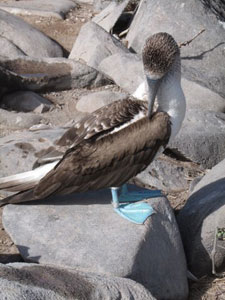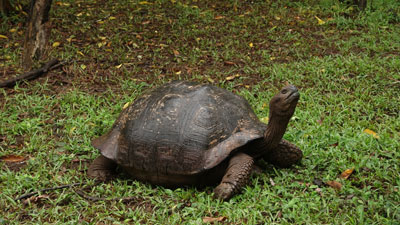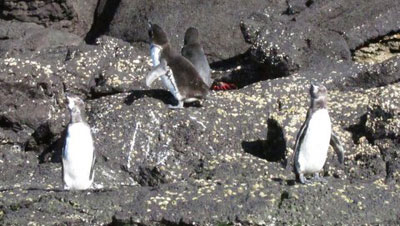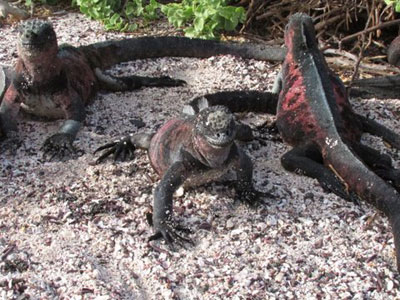
Blue-footed boobies population numbers are declining.
|
THE GALAPAGOS ARCHIPELAGO – The iconic Galapagos blue-footed boobies pay no heed to global climate change negotiations.
They don’t give a drat, could hardly care less.
But along with numerous other endemic and unusual species on the world-renowned islands first made famous by the work of Charles Darwin, they may well be fretting about their declining numbers.
The booby population has shrunk over the past couple of decades, say two seasoned Galapagos National Park naturalists and science educators who led a recent visit on the MV Origin, owned by the Ecuadorian-owned Ecoventura, Inc.
Science educator and park naturalist Maria Gabriela Espinoza Peña – aka Gabby – explained to 14 American and German visitors that she sees the changes in just the 26 years she’s been working as a naturalist in Galapagos.
Species confronting climate risks
A year-round resident of a coastal town near Guayaquil, on Ecuador’s west coast some 1,000 kilometers (about 620 miles) from Galapagos, Gabby explained that the world-famous Galapagos islands, in the late ’80s and early ’90s, were home to some 20,000 blue-footed booby couples.
Researchers indicate that they now number approximately 6,000 in total. (During that same 26-year stretch, she noted, annual tourism to Galapagos has soared from about 8,000 to about 200,000.)

‘Humongous’ Galapagos tortoises are not immune to stresses posed by the changing climate.
|
Along with the decline in blue-footed boobies, there are also concerns about the populations and prospects of a number of other land and sea species: for instance, the sizes and numbers of schools of the remarkably colorful fish that thrill snorkelers and scuba divers exploring the islands’ clear, and often quite brisk, Pacific waters.
Even the Galapagos’ famed giant tortoises are not exempt from potential adverse impacts as their preferred foods and cooling-off freshwater ponds become less common.
Consider cautions expressed by the Galapagos Conservation Trust and the United Kingdom’s Royal Geographic Society:
Marine iguana: Much like turtles, increased temperatures could interfere with egg development and coastal erosion would reduce nesting area availability. Changes in air temperature could also interfere with iguanas’ ability to regulate body temperature as they are cold-blooded.
Blue footed booby: During El Niño events when temperatures are warmer, blue footed boobies have abandoned breeding colonies and increased migrations. Therefore, increases in temperature due to climate change have the potential to have similar effects. Sea level rise could also cause nest losses. Reduced upwelling would also reduce their food supply.
Land iguanas: Changes in air temperature could interfere with iguana’s ability to regulate temperature much like the marine iguana. Changes in rainfall could reduce nesting success.
Galapagos penguins: From spotting 20 or 30 to now two or three
“The food chain is broken,” Gabby said in explaining the falloff in numbers. And the same applies to the islands’ declining numbers of penguins, which generally are about a foot-and-a-half high. She points to higher air temperatures and warmer sea temperatures as likely causes.

Galapagos penguins are smaller than those in Antarctica.
|
“We used to see big groups, like 20 to 30, now it’s more like two or three.”
With too much nutrient pollution and warmer sea temperatures, there’s less Ulva lactuca, the edible green algae the penguins like and can digest. With less of their preferred diet available, they sometimes are forced to turn to brown algae, which they can’t digest and which can lead to constipation and also to their demise, she says.
Asked if she sees benefits also arising from the changing climate, Gabby pauses before saying, “I wish I could say positive things about that, but I think it’s the opposite.”
“I want to be positive in looking to the future of this magical place that belongs to the whole world,” she says. “I have witnessed global warming, so I hope the powerful countries that have the power to do something will do it.” She points to the December 2015 Paris Agreement as providing some cause for hope.
But her optimism is conditional: “I think the moment that the powerful people will see they are in danger, they will do it.”
In ‘middle of nowhere’ … yet surrounded
A fellow naturalist aboard the Origin, Santiago Moran, has worked in the park for going on three decades, 15 years as a naturalist. Before that, and still, he has worked as a diving guide.

Galapagos National Park naturalists 'Gabby' Peña and Santiago Moran.
|
Like his naturalist colleague, he refers to the Galapagos not just as a part of Ecuador but as belonging to the world.
Born and raised in the Galapagos isle of San Cristobal, Moran says that as a scuba diver he has seen “dramatic change” in shark populations. “We used to see schools of sharks, now we see few of them,” specifically referring to Galapagos sharks, whale sharks, and silky sharks.
Santiago – “Santi” as he is known to his friends – points to over-fishing, ocean acidification, rising sea temperatures, and oil and heavy metals as posing increasing problems over the past 20 years.
“Galapagos is in the middle of nowhere,” he says of its location in the Pacific Ocean west of Ecuador and just below the Equator. “But we’re surrounded by different currents, coming from distant places.” He singles out North America, South America, and Central America, “and all those contaminations are coming from there.”
“Even though Galapagos is isolated,” he says, “it is subject to the changes coming from anywhere, absolutely dependent.”
In addition to finding fewer blue-footed booby birds, he sees behavioral changes and population declines for albatrosses, petrels, and migratory birds.
“Once the ocean is affected, and there is less nutrients, less fish, animals like birds feel the stress. And they will not be spending the same energy if they don’t have enough food supply,” he says.
“It’s the same way with humans: If you don’t have the savings, you will not be spending on extra things. It’s the same happening with nature: animals are smart, and they will not be reproducing – having two or three chicks a year – if they cannot supply enough food.”
What the kids and grandkids will see … ‘Whoa! That’s sad’
Asked how he feels knowing his children – ages four and two, with a third child due later this year – might find a changed Galapagos, Santiago says, “It’s a very good question, because Galapagos now is in a very good shape. But 20 years ago, since maybe 30 years ago when I came my first time, I have seen the changes. It’s not only pollution, but also the human impact.”
“For me to see that and think about what my kids will see is a worry, because they will not have the same chance to see what I did see.” He recalls fishing as a youth for a half-hour from a local pier and catching five to 10 pounds of snappers or groupers. “Now it’s all commercial, they have to make the money to buy that.”

Land iguanas are abundant on some Galapagos islands, but face challenges regulating their body temperature.
|
It’s a future that today’s children and grandchildren may find substantially different from the Galapagos their earlier relatives may have witnessed.
Karl, a well-travelled German youth on board Origin with his twin 15-year-old brother Paul and family, shared a concern expressed also by Santiago: commercial pressures. “They’re great,” he said of his first visit to the Galapagos islands, but he fears they “may change because of money reasons.”
If he returns sometime in the future, perhaps with his own children, “I would like to see the same place I see here in the moment now, the turtles and birds and so forth. I hope it stays like this.” He said he hopes major economic powers such as the U.S., China, Japan, Western Europe, and his own country of Germany will do more to help.
But in his words, “They don’t make it easy for the plants and animals.”
The youngest of the 14 passengers on the late-August seven-day cruise, Rowan, visiting from New York City with her 10-year-old sister Clara and their parents, said of Galapagos, “I think it’s beautiful, and there’s a lot of fresh air. And there’s lots and lots of water, and the islands are pretty small.”
Rowan singled-out the “humongous” tortoises, blue-footed boobies, and iguanas as being of particular interest.
Asked how she feels about the prospects of declining populations of some species, Rowan didn’t hesitate: “Whoa! That’s sad.”
It’s a sentiment her 10-year-old traveling companion and sister Clara readily endorsed, as might other children in coming decades.
Editor’s Note
It’s not “new” news that Galapagos is feeling the effects of the changing climate, only that those effects are becoming more pronounced, more widespread, and seen firsthand by more visitors.
Reuters’ science news service in 2009 reported that “Scientists say abrupt and frequent changes in sea temperatures and the death of coral reefs near the islands show that global warming is taking its toll on local sea life.”
And Cornell University’s Lab on Ornithology reports that “Global warming has been shown to be a leading cause of the increasing prevalence of El Niño, which is a major reason for the Galapagos penguins’ endangered status. Researchers estimated that the species has a 30 percent chance of going extinct in the next 100 years, even without assuming that El Niño events will occur more frequently and severely.”
Additional information about Galapagos and impacts of climate change is available from the Galapagos Conservancy.
(Photo credits: Bud Ward)
|
ABOUT THE AUTHOR
Bud Ward is Editor of Yale Climate Connections. He started his environmental journalism career in 1974. He later served as Assistant Director of the U.S. Congress's National Commission on Air Quality, before founding The Environmental Forum magazine in 1982. In 1988 he established Environment Writer for journalists covering natural resources and environmental issues.
|